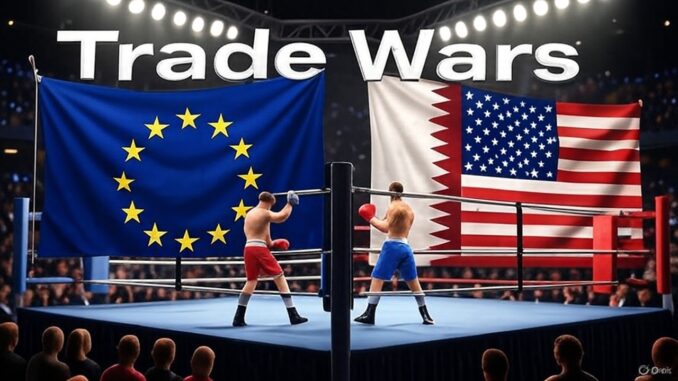
In an escalating tension over global energy trade, the European Union’s push for stringent climate and sustainability regulations has drawn sharp rebukes from major LNG suppliers, the United States, and Qatar. Both nations have issued stark warnings that these rules could disrupt vital liquefied natural gas (LNG) supplies to Europe, potentially jeopardizing the continent’s energy security amid ongoing efforts to diversify away from Russian imports. At the heart of the dispute is the EU’s Corporate Sustainability Due Diligence Directive (CSDDD), which mandates companies to scrutinize their supply chains for environmental and human rights risks, with hefty fines for non-compliance.
This directive, seen by critics as regulatory overreach, applies to both EU and non-EU firms operating in the bloc, raising concerns about extraterritorial enforcement and its impact on international trade. The CSDDD, formally adopted in 2024, requires large companies—those with over 1,000 employees and €450 million in global turnover—to identify, prevent, and mitigate adverse impacts in their operations and supply chains.
For energy giants like U.S. LNG exporters and QatarEnergy (a state-owned entity), this means potential liability for upstream emissions, labor practices, and environmental harms far beyond Europe’s borders. Non-compliance could trigger fines up to 5% of global turnover, civil lawsuits, and exclusion from EU public procurement.
Qatar has been particularly vocal, with officials stating they would halt LNG shipments to the EU if fined under the law, arguing it unfairly targets sovereign entities and could breach trade agreements.
Similarly, industry leaders have labeled the directive as a “bone-crushing burden” that undermines American sovereignty and complicates bilateral trade deals.
This backlash comes as Europe remains heavily reliant on imported LNG to fill the gap left by curtailed Russian pipeline gas. In 2024, the EU imported approximately 55 billion cubic meters (bcm) of LNG from the U.S., accounting for about 40-50% of its total LNG imports and making the U.S. the bloc’s largest supplier.
Projections for 2025 suggest U.S. volumes could hold steady or rise slightly to around 50-60 bcm, driven by expanding U.S. export capacity and Europe’s ongoing demand, with the U.S. expected to supply up to 70% of Europe’s LNG by 2026-2029.
Qatar, the EU’s third-largest LNG supplier, delivered about 20 bcm (equivalent to 15 million tonnes) in 2023 and roughly the same in 2024, with estimates for 2025 projecting similar levels as Qatar ramps up its North Field expansion.
Combined, these two suppliers represent over 60% of the EU’s LNG imports, totaling around 70-80 bcm annually—a volume that, if disrupted, could force Europe back into higher-priced spot markets or renewed dependence on other sources. The potential trade impact is staggering. If the threats from the U.S. and Qatar materialize, the EU could face a shortfall of up to 80 bcm of LNG per year, equivalent to about half of its total imports in recent years.
This disruption might drive up energy prices, exacerbate inflation, and hinder industrial recovery in key sectors like manufacturing and chemicals. Analysts warn that the CSDDD’s requirements could add compliance costs of 5-10% to LNG trade deals, potentially rerouting U.S. and Qatari volumes to Asia, where demand is surging without similar regulatory hurdles.
In a broader context, this could undermine the EU-U.S. trade deal, which includes commitments for €700 million in U.S. energy exports annually, and strain global LNG markets already facing capacity additions of 300 bcm by decade’s end, primarily from the U.S. and Qatar.
Critics argue the CSDDD exemplifies EU regulatory overreach, imposing burdensome obligations on foreign entities without adequate consultation, much like the United Kingdom’s Carbon Border Adjustment Mechanism (CBAM).
The UK’s CBAM, set to launch in 2027, levies a carbon price on imports of high-emission goods like steel and cement to prevent “carbon leakage,” mirroring the EU’s own CBAM (which began transitional reporting in 2023 and goes full-scale in 2026).
However, key differences highlight varying approaches: the UK CBAM excludes electricity and has a narrower sector scope initially, while the EU version ties directly to its Emissions Trading System (ETS) prices and includes more products.
Both mechanisms aim to level the playing field for domestic industries but have sparked trade disputes, with exporters claiming they act as disguised tariffs. The CSDDD goes further by enforcing due diligence across entire value chains, potentially affecting energy trade indirectly through sustainability mandates, whereas CBAMs target embedded carbon emissions more explicitly.
U.S. officials, including members of Congress and state attorneys general, have urged the Trump administration to counter this “EU regulatory overreach” in trade negotiations, emphasizing that it threatens American jobs and energy independence.
Qatar echoes these sentiments, viewing the directive as a sovereignty infringement.
As the EU Parliament considers amendments amid pushback, the standoff underscores a broader clash between climate ambitions and energy realities.
For Europe, balancing green goals with secure supplies will be critical, especially as global LNG capacity surges and competition intensifies. This development highlights the energy sector’s resilience amid policy uncertainties, with U.S. producers continuing to innovate and boost output despite regulatory headwinds.
The Bottom Line
The EU leadership, in line with the UK, wants war to keep their funding going, and the CSDDD and the CBAM are just like the UN’s maritime carbon tax initiative, and they are designed for one thing – Control. They want to control the population, and that is 100% the end game. We are about to see some critical turning points, and I do not see how the EU leadership can survive this trade war, let alone keep the EU together. The strikes on Hungary and Romania’s refineries are in question, and appear to be a Ukrainian attempt to draw NATO into the war. These are all related to the CSDDD and the CBAM, as it is about control and money.
Stay tuned to Energy News Beat for updates on how these trade dynamics evolve.
Got Questions on investing in oil and gas? Or do you have a Tax Burden in 2025?
Crude Oil, LNG, Jet Fuel price quote
ENB Top News
ENB
Energy Dashboard
ENB Podcast
ENB Substack






Be the first to comment